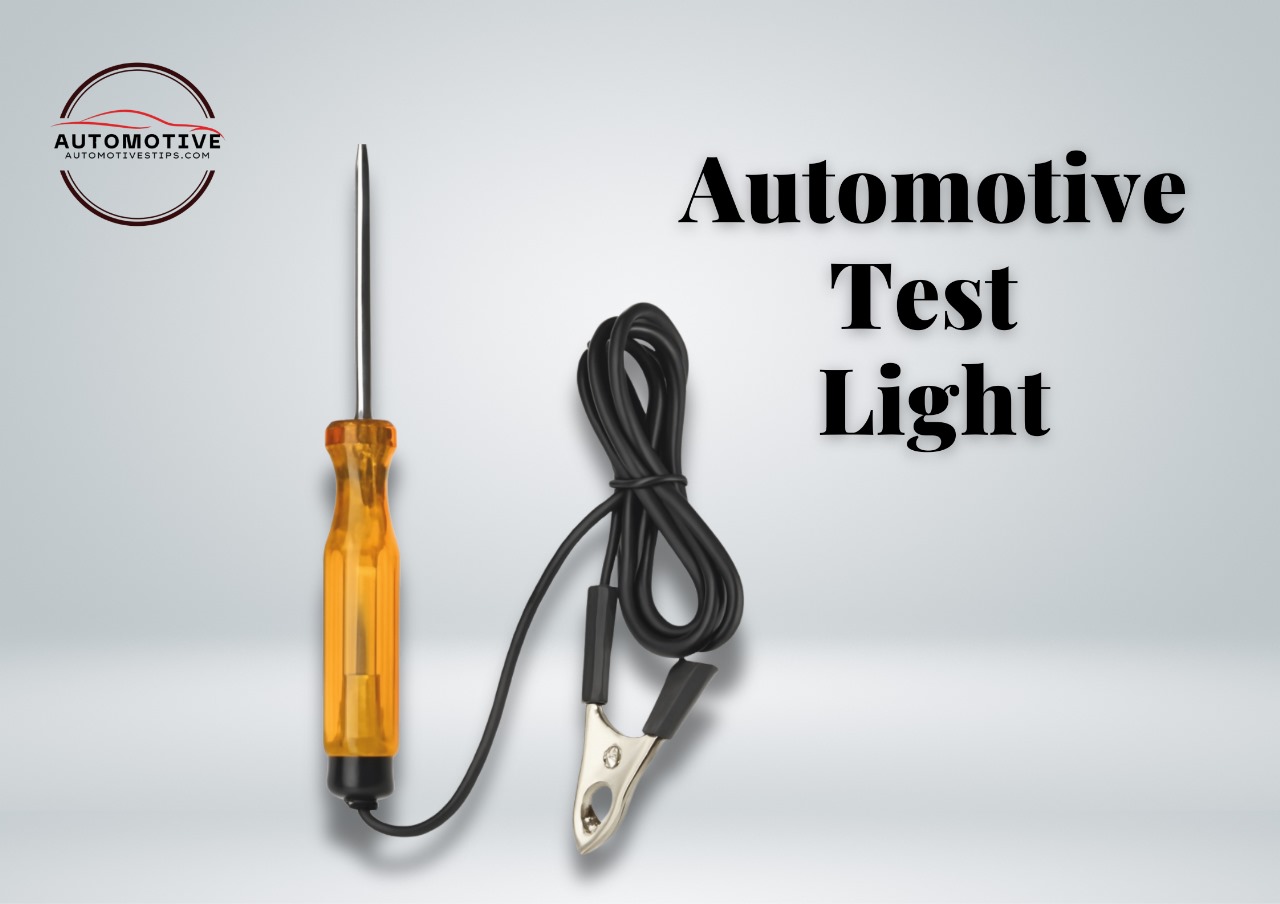Evolving Technology and Automotive Electrical Systems
As technology continues to evolve, the electrical systems in modern vehicles have become increasingly complex. From electronic fuel injection to advanced infotainment systems, these technologies depend on a complex network of wiring, sensors, and circuits to operate properly. When electrical problems arise, it can be challenging to pinpoint the issue without the right tools.
The Role of an Automotive Test Light
An automotive test light is a handy diagnostic tool designed to detect the presence of voltage in an electrical circuit It can quickly determine if a circuit is powered or if there’s an issue with the wiring or components, such as a blown fuse, malfunctioning switch, or faulty light bulb.
What You Will Learn in This Guide
This comprehensive guide will cover everything you need about automotive test lights. From understanding what they are and how they work to using them in advanced diagnostics and troubleshooting common issues, this article will provide in-depth knowledge that ensures you are fully equipped to use an car test light effectively in vehicle diagnostics.
Table of Contents
- What is an Automotive Test Light?
- The Importance of an Automotive Test Light
- Types of Automotive Test Lights
- Incandescent Test Light
- LED Test Light
- Digital Test Light
- Why Use an Automotive Test Light?
- Common Uses of Automotive Test Lights
- Diagnosing Power in Circuits
- Checking Fuses
- Testing Light Bulbs and Electrical Components
- Verifying Ground Connections
- Checking Sensors and Switches
- Benefits of Using an Automotive Test Light
- Quick Diagnosis
- Cost-Effective
- Safety
- Versatility
- How to Use an Automotive Test Light
- Step-by-Step Guide
- Important Safety Tips
- Using Advanced Features of Digital Test Lights
- Choosing the Right Automotive Test Light
- Factors to Consider
- Features to Look for
- Best Brands and Models
- Comparing Test Lights with Other Diagnostic Tools
- Troubleshooting Common Test Light Issues
- Identifying and Fixing Problems with Your Test Light
- In-Depth Guide for Diagnosing Test Light Malfunctions
- Best Practices for Maintaining an Automotive Test Light
- Frequently Asked Questions (FAQs)
- Conclusion
- Additional Resources
1. What is an Automotive Test Light?
An automotive test light is a diagnostic tool used to verify if a specific electrical circuit in a vehicle is receiving power. The tool is designed to be simple yet effective. The basic function of a test light is to illuminate when it makes contact with a live circuit, indicating that the circuit is energized. Automotive test lights are essential for troubleshooting various electrical problems, such as testing fuses, checking light bulbs, and verifying whether sensors or switches are receiving Power.
The design of a test light usually consists of a metal probe that can be inserted into the vehicle’s wiring or fuse box, along with a clip that attaches to a ground point, such as the vehicle’s frame. The presence of Power in a circuit will cause the light to turn on, providing an immediate indication of whether the circuit is functional. This makes test lights invaluable for diagnosing electrical issues without disassembling the vehicle’s electrical system.
2. The Importance of an Automotive Test Light
Electrical problems are one of the leading causes of vehicle malfunctions. A blown fuse, damaged wiring, a faulty light bulb, or a malfunctioning switch can all prevent critical components from functioning correctly. Diagnosing these issues without the proper tools can be time-consuming and complicated. This is where an automotive test light becomes essential to any mechanic’s toolbox. It provides a quick and efficient solution for identifying electrical problems in a vehicle. Whether you’re testing circuits, checking fuses, or inspecting the wiring, an automotive test light makes it easier to pinpoint issues, saving both time and effort in the repair process.
Here’s why automotive test lights are essential:
- Fast Diagnostics: Test lights provide immediate feedback on whether an electrical circuit is live. They eliminate the need for guesswork or excessive disassembly, making diagnostics quicker and more efficient.
- Cost-Effective: Test lights are inexpensive tools that can save money by allowing you to perform basic diagnostics and repairs yourself. Professional diagnostic equipment like digital multimeters and oscilloscopes can be much more costly.
- Prevents Further Damage: Identifying electrical issues early with a test light can prevent further damage to your vehicle’s electrical system, helping you avoid more expensive repairs down the line.
- Simplicity and Ease of Use: Test lights are simple to use and require no technical expertise. They provide an immediate visual cue, making them user-friendly for beginners and professionals.
- Safety: Using a test light significantly reduces the risk of electrical shocks compared to working with live wires directly. Many test lights come with insulated handles and grounding clips for added protection, ensuring maximum safety and reliable performance during use.
3. Types of Automotive Test Lights
Automotive test lights come in different styles to suit various needs and applications. The three main types are incandescent test lights, LED test lights, and digital test lights. Let’s explore these types in more detail:
Incandescent Test Light
The traditional incandescent test light, which has been around for decades, uses a filament bulb to illuminate when the circuit has Power. It is the simplest form of test light.
- Best for: Simple diagnostics, especially on older vehicles with more basic electrical systems.
- Pros:
- Affordable and easy to use.
- Its straightforward design makes it user-friendly for beginners.
- Available in most auto parts stores.
- Cons:
- Bulbs burn out quickly, requiring regular replacement.
- Less energy-efficient compared to newer models.
- Dimmer illumination can make it harder to see in bright environments.
LED Test Light
LED test lights are an upgrade from traditional incandescent versions, offering several advantages, such as a longer lifespan and higher energy efficiency.
- Best for: Modern vehicles, where brighter and more reliable lighting is needed.
- Pros:
- Long-lasting and energy-efficient.
- Brighter illumination for better visibility in various conditions.
- More durable and resistant to shock.
- Cons:
- More expensive than incandescent test lights.
- It might be. It is not as widely available in basic designs.
Digital Test Light
Digital test lights are the most advanced type of automotive test light, providing accurate voltage readings and visual indicators.
- Best for: Advanced diagnostics where precision is necessary.
- Pros:
- Provides accurate voltage readings on a digital screen.
- More versatile, capable of measuring a wider range of voltages.
- Ideal for troubleshooting complex electrical problems.
- Cons:
- Expensive compared to basic test lights.
- Requires more technical knowledge to operate correctly.
4. Why Use an Automotive Test Light?
There are numerous advantages to using an automotive test light in vehicle diagnostics. Let’s take a closer look at the key reasons why this tool is essential:
Quick Diagnosis
One of the most important benefits of using an automotive test light is its ability to provide immediate results. When testing a circuit, the light will illuminate right away if the circuit is powered. This allows you to pinpoint problems quickly, without extensive testing or disassembly.
Cost-Effective
Automotive test lights are relatively inexpensive compared to professional diagnostic tools like multimeters and oscilloscopes. A basic incandescent test light costs under $10, making them affordable for DIY mechanics and hobbyists. Digital models will be more expensive but offer a cost-effective alternative to more advanced equipment.
Safety
An automotive test light is designed with safety in mind. It prevents you from making direct contact with live wires, reducing the risk of electrical shock. Many models come with insulated handles and grounding clips, providing additional protection when testing circuits.
Versatility
Test lights can be used in various situations, including:
- Diagnosing Power to a component
- Checking fuses
- Verifying ground connections
- Testing light bulbs
- Checking relays, switches, and sensors
5. Common Uses of Automotive Test Lights
Automotive test lights are versatile tools, and they are widely used in diagnostics. Here are some of the most common applications for automotive test lights:
Diagnosing Power in Circuits
The primary function of a test light is to determine whether a circuit is receiving Power. This can help check whether a fuse is blown, whether a component is receiving Power, or if there is a wiring fault.
Checking Fuses
Fuses are designed to protect the electrical system from excessive current by breaking the circuit. A blown fuse will stop the flow of Power to components. You can use a test light to check fuses and determine if they are blown. Place the probe on both sides of the fuse. If the light illuminates on both sides, the fuse is intact.
Testing Light Bulbs and Electrical Components
Test lights are often used to check the electrical Power of light bulbs, sensors, and switches. If a bulb or component is not working, a test light will help you identify whether the issue is due to a lack of Power or a malfunctioning component.
Verifying Ground Connections
Electrical failures in vehicles are often caused by grounding issues. Test lights can help verify the integrity of ground connections. By testing the negative side of a circuit, you can ensure that the grounding point is functioning correctly.
Checking Sensors and Switches
In a vehicle, sensors and switches manage various electrical functions. Test lights help diagnose whether these components are receiving Power and functioning as intended.
6. Benefits of Using an Automotive Test Light
Automotive test lights offer numerous benefits for both professionals and DIY enthusiasts. Below are some of the key advantages:
Quick Diagnosis
When diagnosing electrical problems, time is of the essence. A test light allows you to quickly check for Power in circuits, reducing the time spent troubleshooting. This immediate feedback allows for faster repairs and minimizes your vehicle’s time in the shop.
Cost-Effective
Test lights are inexpensive compared to complex diagnostic equipment like multimeters or oscilloscopes. This makes them an affordable choice for individuals who need a fundamental tool for diagnosing electrical issues. For DIY enthusiasts, this cost-effectiveness means that a simple test light can save you money on costly repairs or services.
Safety
Using a test light eliminates the need to directly contact live circuits, reducing the risk of electrical shock and making the diagnostic process safer for the mechanic or car owner. Insulated handles and grounded probes add an extra layer of safety during use.
Versatility
Test lights are versatile and can be used to troubleshoot various electrical issues. Whether testing fuses, checking light bulbs, verifying ground connections, or diagnosing Power to components, a test light provides a quick and reliable solution.
7. How to Use an Automotive Test Light Step-by-Step Guide
- Prepare the Test Light: Attach the clip to a grounded part of the vehicle, such as the metal frame or a designated ground point.
- Turn on the Vehicle: For most electrical systems, the vehicle should be turned on or the component should be powered on.
- Probe the Circuit: Touch the probe to the wire or component you want to test. If the circuit is live, the test light will illuminate.
- Check the Grounding: Place the probe on the negative terminal or ground wire to verify the ground connection.
Important Safety Tips
- Always disconnect the vehicle’s electrical system when working with high-voltage components such as the alternator or battery.
- Use an insulated test light to avoid the risk of electric shock.
- Inspect the test light for damage before use to ensure its safety and effectiveness.
8. Choosing the Right Automotive Test Light
When selecting an automotive test light, it’s essential to consider the following factors:
Voltage Range
Ensure the test light is rated for your vehicle’s voltage. Most vehicles operate on a 12V electrical system, but larger trucks or commercial vehicles may have a 24V system. Choose a test light suitable for the voltage you’re working with.
Durability
LED test lights are more durable and longer-lasting than incandescent models. If you frequently use the test light, an LED version may be the best choice.
Precision
Consider a digital test light that provides precise voltage readings for more advanced diagnostics. This is especially helpful for troubleshooting complex electrical issues in modern vehicles.
Top Brands and Models
- Fluke 1AC-II: Known for its accuracy and reliability, Fluke test lights are widely used by professionals.
- OTC 3650: A popular incandescent test light that is simple and reliable for basic diagnostics.
- Lisle 27700: An affordable LED test light with excellent durability and longevity.
9. Troubleshooting Common Test Light Issues
Test lights are generally simple tools, but like any diagnostic device, they can experience issues. Here’s a guide to troubleshooting common problems:
Test Light Won’t Illuminate
This could be due to a blown bulb, faulty wiring, or a poor connection. Check the wiring and connections to ensure the light is correctly connected to the circuit.
Flashing Light
If the light flickers or dims, it may indicate unstable or fluctuating voltage. This could be caused by a loose connection or a faulty component in the circuit.
No Light on Both Sides of the Fuse
It is likely blown if the test light doesn’t illuminate when checking a fuse. Alternatively, check the fuse holder for damage or corrosion.
10. Best Practices for Maintaining an Automotive Test Light
To ensure your automotive test light remains functional, follow these maintenance tips:
- Store Properly: Always store your test light in a dry, cool place, away from moisture and extreme temperatures.
- Check for Damage: Periodically inspect the probe and wiring for any signs of wear or damage. Replace any damaged components to maintain safe and effective operation.
- Clean the Probe: Ensure that the probe is free from dirt and debris, which can affect its ability to make proper contact with circuits.
11. Frequently Asked Questions (FAQs)
Q: Can I use an automotive test light to check the battery voltage?
A: Test lights can help verify that the battery is receiving Power. However, a multimeter is recommended for accurate voltage readings.
Q: How do I know if my vehicle needs an automotive test light?
A: If you are experiencing electrical problems such as non-functioning lights, sensors, or blown fuses, a test light can help you quickly identify the issue.
Q: Are automotive test lights suitable for all vehicles?
A: Most test lights are designed for vehicles with 12V electrical systems. Check the specifications of the test light for high-voltage vehicles to ensure compatibility.
12. Conclusion
Automotive test lights are crucial tools for diagnosing electrical problems in vehicles. Their simplicity, affordability, and versatility make them invaluable for professionals and DIY mechanics. Whether you’re testing fuses, verifying Power to components, or troubleshooting ground connections, a test light provides quick and reliable results. By understanding the different types of test lights, their uses, and how to troubleshoot issues, you’ll be better equipped to maintain and repair your vehicle’s electrical system efficiently.
With the information in this guide, you can confidently choose, use, and maintain your automotive test light, ensuring that you can diagnose and fix electrical problems quickly and effectively.
Tables:
| Type of Test Light | Pros | Cons |
| Incandescent | Simple, inexpensive, easy to use | Short lifespan, burns out quickly |
| LED | Long-lasting, bright, energy-efficient | More expensive |
| Digital | Accurate, versatile, high-quality | Expensive, requires technical knowledge |
| Use Case | Description | Test Light Type |
| Diagnosing Power | Verifies if a circuit is live | All types |
| Checking Fuses | Checks if a fuse is intact | Incandescent, LED |
| Testing Components | Tests the power to lights and other components | Digital, LED |






Leave a Reply